

Casale di Clio (why ‘casale’? see below) is our ‘house in the hills’ above Bagni di Lucca, in Northern Tuscany – on the edge of the beautiful Garfagnana (which includes two mountain ranges: Apuan Alps and Apennines). We provide accommodation and a convivial environment in a small and picturesque hamlet, with wonderful views over and along the Lima Valley (and also of Monte Prato Fiorito, literally ‘Flowery Meadow Mountain’). We have a dedicated page providing more information about our location.
The House
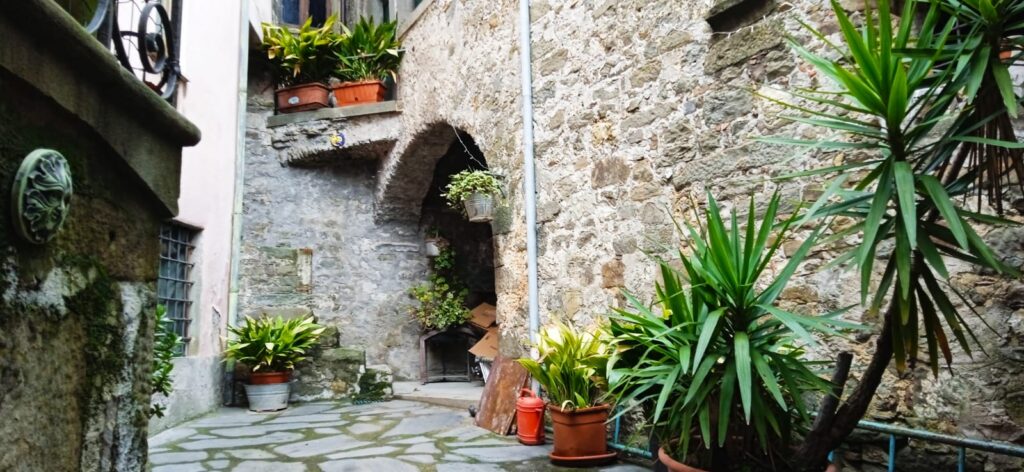
In addition to your own ‘study bedroom’ (see Rooms and Rates), tenants will have access to the Casale di Clio areas below:
Library
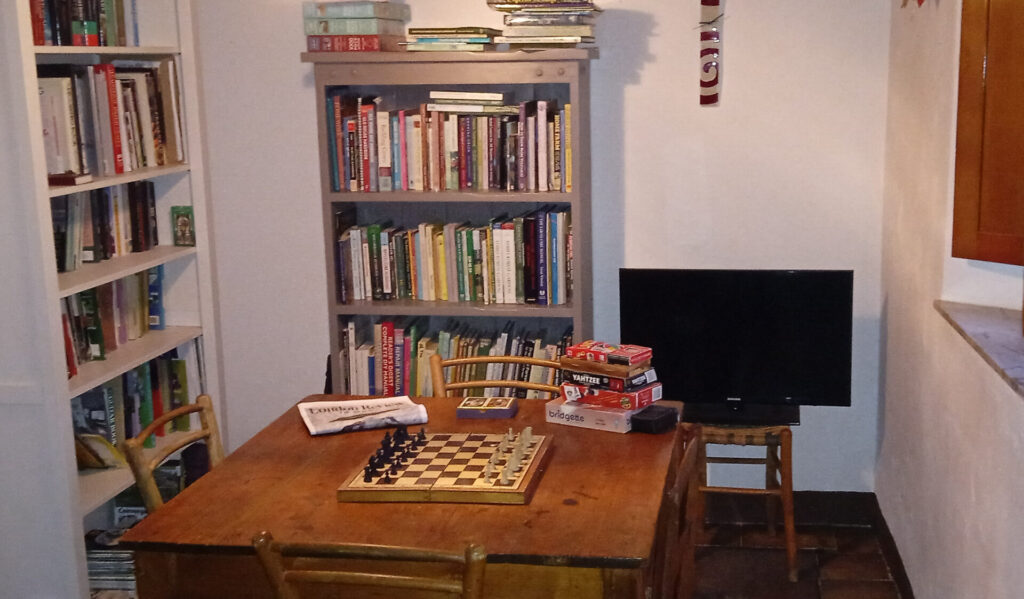

The Library contains an eclectic mix of books, including collections on subjects such as: Tudor and Stuart History, (with a focus on the Wars of the Roses and the theatre of the period; cooking, nutrition and health (including yoga), and travel – as well as a range of fiction and reference books. Notably, there is a selection of self-study books on creative writing, drawing, painting and music – as well as traditional crafts. We receive the London Review of Books and Writing Magazine.
There is a particularly large collection of books on Sustainable Land Use and Management (including Permaculture, Forest Gardening, Seed-Saving and Woodland Management) – reflecting the fact that in addition to writers and artists we welcome those who might be interested in a Land Study Holiday.
You will also find Italian language learning resources, jigsaw puzzles, board games – and a table at which to study or play. A television is stored in the library, where it can be used to watch something from the small collection of DVDs (with due regard to the other tenants, especially in the ‘quiet hours’). The library also contains a couple of yoga mats for tenants’ use.



Our Yamaha PSR 400 keyboard (with MIDI capability) is stored in the library, along with instruction/self-study materials; these are available to tenants who might want to either have a go at learning to play the keyboard or spend time here on a composition.
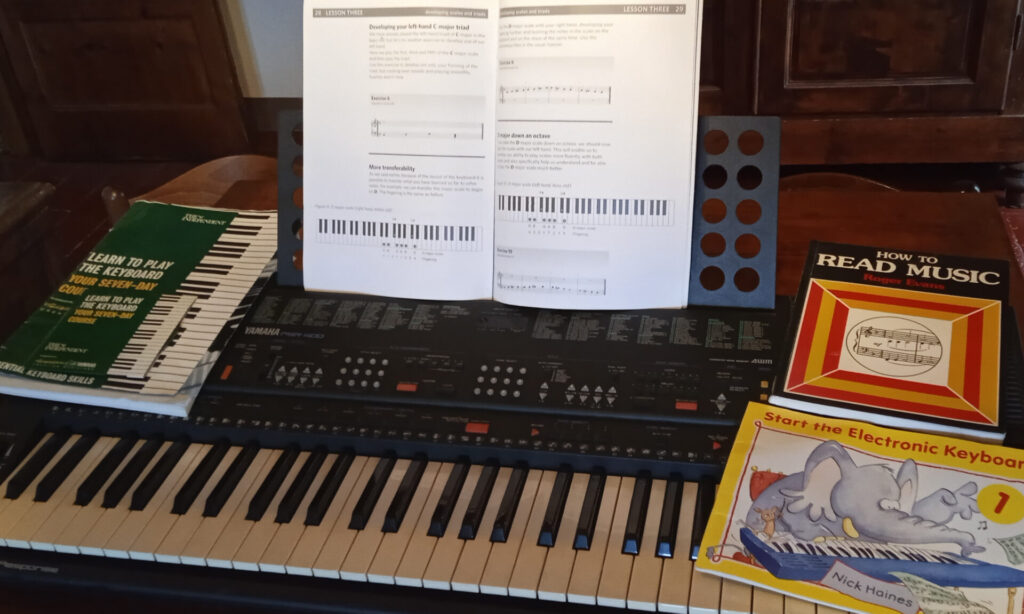
Kitchen

The kitchen – which is shared by us and tenants – has a large fridge-freezer, with space allocated for tenants, and two ovens, one of which is a newly-installed cucina a legna (wood-fired cooker, with hotplate and oven).
In the Winter months, the cucina a legna is likely to be lit for much of the day, providing a cosy atmosphere and the opportunity to boil a kettle for a ‘cuppa’ without having to use any gas or electricity.
Sitting Room
Like the kitchen, the sitting room has a newly-installed wood-burning stove for extra cosiness during the cooler months – complete with hotplate for warming a pot of milk for hot chocolate if that is your thing (or some mulled wine!), or for roasting chestnuts from the woodland! There is also comfortable seating, including two sofas, and book-cases with a range of reading material to supplement that in the library.

Dining Room


A table large enough to seat 10 for dinner forms the centerpiece of the dining room. This is complemented by various items of traditional furniture, with several original paintings displayed on the walls.
The dining room is where you are most likely to hear music; mostly from a modern radio/cd player – though with the occasional burst of Edith Piaf (or one of a select few other artists) from the gramophone! We’ll usually have light relaxing music on during breakfast time, before morning ‘quiet hours’; during the evening tenants can decide between them what, if anything, to have playing in here .

The balcony (see below) that leads off of the Dining Room offers spectacular views, and is a great spot for reading, study, relaxation or aperitivi/hot chocolate – depending on the time of day, and the time of year!
Guest Bathroom
The bathroom is usually shared by occupants of the two main guest rooms, although there is the option of securing exclusive use of the bathroom by paying a 100 Euro per week supplement, meaning that we will not let another guest room for that week. We have a third guest room available for those who book with people whom they know and with whom they would be happy to share a bathroom.
Like the traditional Italian bathroom it contains a bidet – unlike the traditional Italian bathroom it contains a bath as well as a shower – though we ask guests to check/agree with any fellow guest(s) before running a bath, so as not lead to their fellows being ‘inconvenienced’ at a time of need!
Balcony

The balcony is accessed from the dining room and contains a small table and some seating. This spot – a favourite for enjoying aperitivi and stuzzichini on Summer evenings – provides spectacular views both across the Lima Valley (of wooded hillsides containing three traditional hill-villages, complete with a tower each, if you can pick them out) – and up the Lima Valley (of several other hill-villages).
Terrace
The terrace, where a table and chairs take cover beneath grapevines and the jasmine that grows up towards the balcony, is a good spot for a little light reading or study, or even an alternative place to take breakfast, lunch or dinner (or aperitivi!).
Equipped with a BBQ, the terrace provides the ideal perch to say ‘Ciao!‘ to any passing neighbours (particularly if you want to practice your Italian language skills) – be aware though: you are likely to be carefully observed by the menagerie of local cats!

‘Art Barn’

We are developing our ‘Art Barn’ as a large, bright multi-purpose space: art/crafting/exhibition/yoga studio – or quiet reading spot, with the possibility of placing a writing desk by the window overlooking Monte Prato Fiorito (contact us for a progress report!)

Garden

In the heat of high Summer, the aspect of the garden and the height of the house mean that the garden – complete with olive trees – provides welcome shade. In Autumn, the sun swings around to the garden side of the house, providing welcome warmth even late into October, when large sun-shade umbrellas and deckchairs remain available.
Orto
A very short stroll along the lane that passes down behind Vetteglia’s church (not active, except when the bells in the tower peal on its Saint’s Day) leads down to the orto – the Casale‘s parcel of land for growing food.
When we acquired the Casale in mid-2023 this land – comprising a reasonably flat area at the highest point, and some terraces, which lead down to a larger gently sloped area – was not cultivated. We have a number of pear trees – mostly on the 1st terrace down – an olive tree and a few miscellaneous other trees, mostly oaks. There was a lot of rather weedy long grass, with some thistles (we know about those from our UK smallholding days!) and lots of blackthorn, including one large-ish thicket near the bottom, and a smaller thicket on one of the terraces.
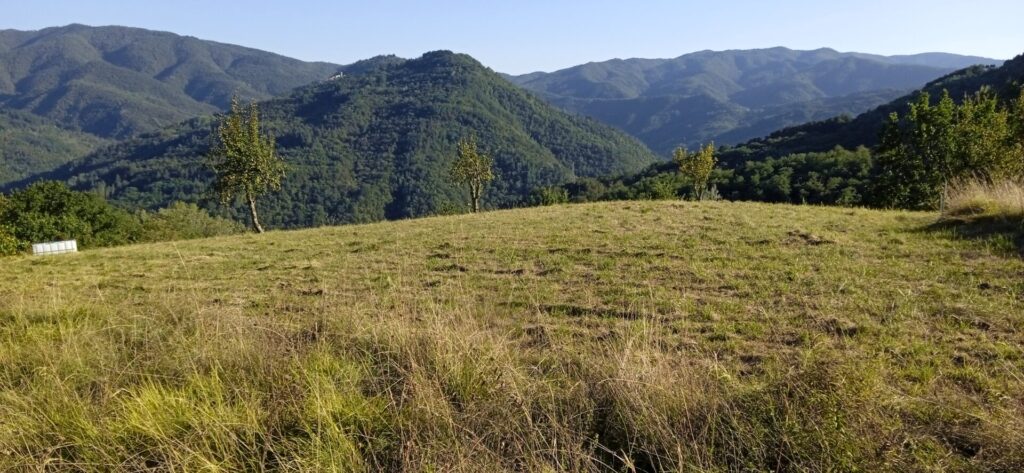
How we approached dealing with the land and started bringing it back into production will be dealt with in future blog posts. For now, it is enough to point out that we think it is a cracking parcel of land – South-facing with wonderful views – having huge potential, and a great spot to set up an easel or sit with a sketch-book!
Woodland

The bosco (woodland) that came with the Casale is spread out over a number of parcels, with much of it sloping quite steeply. It contains hazel, sweet chestnut, (plenty of ‘overstood’ coppice!), along with plenty of invasive acacia (translation: food, firewood and amenity value!).
The footpath that leads to San Cassiano, and its bar/trattoria, shops, and Templar-connected church, heads through our bosco, and is part of the marked Via San Bartolomeo.
A ‘Casale’
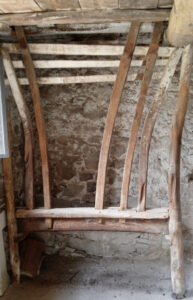
In former times the house formed the main part of the farm complex for the settlement of Vetteglia – the barn and former metato (chestnut drying house) adjoin the small enclosed courtyard at the rear of the casale, and the front terrace still contains the outbuildings that formerly housed hens and goats; the lowest cantina in the casale would have been the byre, and it still contains the old wooden rack where cattle would be fed hay (dropped through a trap-door in the ceiling above).
Tuscany CIR: 046002LTN0117
